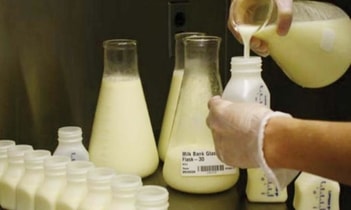Shop Apni Blog
Milk is curdled
Indeed the curdling of milk is quite disappointing as it can sometimes disrupt the routine of the day. Nobody, neither the milkman nor the consumer wants that to happen, as it causes loss of both, money as well as time.
Milk curdling usually happens when protein molecules start attracting each other due to drop in ph level of milk which turns milk acidic. The process is even faster at warmer temperature.
In order to avoid curdling of milk and increase it’s shelf life large dairy companies take various measures like pasteurization and adding chemical preservatives. These processes provide extra duration for milk to sustain and remain sellable and consumable (?). Else milk would curdle within 3-4 hours of milking.
Now coming to the point, despite the heart wrenching experience of milk curdling there is also a positive side of the same. Curdled milk is the self evidence of milk being free of chemical preservatives. Yes, the good news is your milkman has supplied you raw, fresh and chemical free milk.
When there is dilemma of choosing between quality or service, ShopApni will always choose “quality”. That is the promise !
www.shopapni.com
Best Breed of Desi Cow
Many ancient philosophers and even modern scientists have opined that the whole cosmos is governed by an invisible all pervading “intelligence”, and they proposed a theory of intelligent design. All sort of natural processes being carried out all around us are in fact being governed by this intelligence, be it growth of a tree or the blossoming of a flower or even the formation of DNA, the fundamental unit of life.
So the nature which provides us food we consume and the fiber we wear has an underlying intelligence due to which we get the kind of food which suits best in the given climatic conditions. In the country as diverse as India, food habits vary significantly with the variation in climatic conditions, like we see in deserts, mountains, coastal areas or in Gangetic plains people tend to consume different kind of food.
In modern perspective a new food movement called “locavorism” has also started. By definition, “locavore” is a person interested in buying and consuming locally produced food.
Besides many socio economic implications of locavorism the most significant one is that the locally grown food is the best healer of human body. It provides all essential nutrients which our body requires within that particular ecosystem it has been exposed to.
Now lets come to our topic, which breed of Indian cow is best? The answer becomes quite simple now. The one which is found in your region, the one which has survived there for thousands of years, because it has naturally built up an immune system to counter most common diseases found in that region. And it definitely strengthens you up with the same with it’s A2 milk
By this logic, we can conclude that all breeds of cows are good but the best one is your desi cow the LOCAL BREED.
Inconsistency is good !
Inconsistency is good !
Yes, inconsistency is good, especially when it comes to milk. Our customers often report about the slight change in taste and thickness of milk as the climate changes. There are many more factors which determine the taste and fat content of milk, e.g. lactation cycle of cows and fodder we provide to them. As Buddha said, change is the only thing which is permanent in this world ! Standardisation and homogenization of milk keeps the taste and thickness of milk unchanged throughout the year which could be hazardous for human health. Whatever we consume comes from the nature which intelligently provides us nutrition in accordance with climatic conditions. We ought to adhere to laws of nature in order to keep ourselves healthy and wealthy too ![]() So enjoy the change, enjoy the inconsistency in taste and thickness, just cherish the purity !
So enjoy the change, enjoy the inconsistency in taste and thickness, just cherish the purity !
Truth behind sheen of fruits & vegetables
You become what you eat!
A very old saying, that we have listening now and then and keep on ignoring it, but it actually is a great wisdom which warns us that we should be cautious of what we eat because whatever we eat affects us on physical and spiritual levels both.
What do we eat regularly? Grains, pulses, dairy products, and vegetables and fruits. Let us talk about vegetable and fruits here!
We can not imagine our daily food without vegetables and fruits. Food is not just source of energy (as popularly believed now), but they are also essential for proper functioning of our senses and to carry out vital process of continuous renovation of our body. Many cells are built every minute, along with DNA. The building blocks are supplied by foods. Vegetables and fruits supply roughage, fiber, carbohydrate, proteins, various trace elements (zinc, potassium, iron, phosphorus etc.) along with various essential Vitamins.
Is Your Dairy Toxic?
Dairy products are one of the most common foods consumed around the world. Some cultures survive on diets consisting of up to 80% raw cow, goat, &/or sheep milk. In the western world, however, dairy has become one of the most inflammatory foods. A recent discovery shows that a genetic shift in the casein molecule has produced a powerful toxin linked to numerous disorders and diseases.
Milk contains two primary protein molecules: whey and casein. Casein makes up about 80% of the protein in the milk. Casein is made up of 209 amino acids strung together in sequence. The 2 primary forms of casein are: A1 Beta Casein and A2 Beta Casein. These 2 are nearly identical in structure except for the amino acid at position 67. A1 contains histidine while A2 contains proline.










